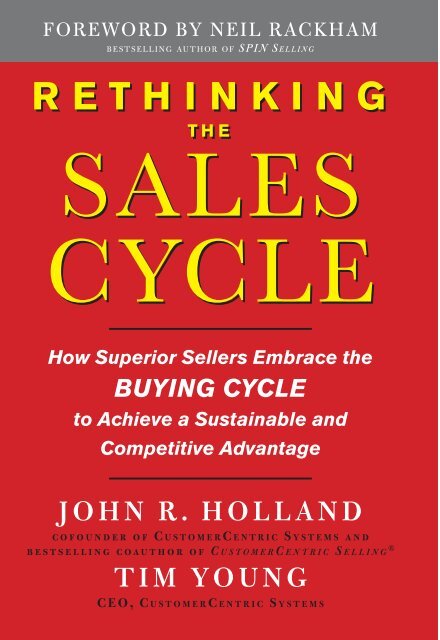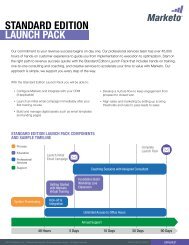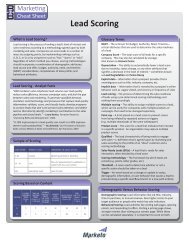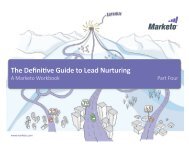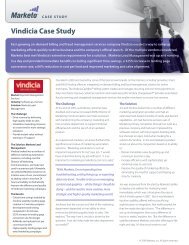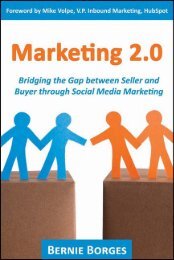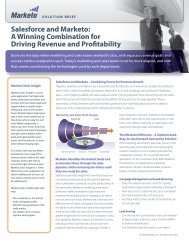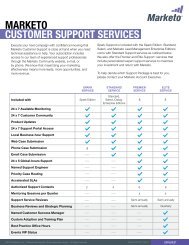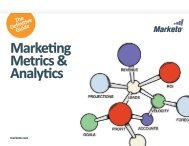RETHINKING RETHINKING - Marketo
RETHINKING RETHINKING - Marketo
RETHINKING RETHINKING - Marketo
Create successful ePaper yourself
Turn your PDF publications into a flip-book with our unique Google optimized e-Paper software.
Foreword by Neil Rackham<br />
b e s t s e l l i n g a u t h o r o f SPIN Se l l i n g<br />
Rethinking<br />
the<br />
Sales<br />
Cycle<br />
How Superior Sellers Embrace the<br />
Buying Cycle<br />
to Achieve a Sustainable and<br />
Competitive Advantage<br />
John R. Holland<br />
cofounder of C u s t o m e r C e n t r i c Sy s t e m s and<br />
bestselling coauthor of C u s t o m e r C e n t r i c Se l l i n g ®<br />
Tim Young<br />
CEO, Cu s t o m e r C e n t r i c Sy s t e m s
C H A P T E R<br />
1<br />
THE ODD COUPLE
4 R E T H I N K I N G T H E S A L E S C Y C L E<br />
Abuyer and a seller make for a really odd couple. When you<br />
think about it, buyers and sellers should be highly compatible.<br />
After all, their relationship should exist solely because each<br />
party can help the other to get something it wants. A buyer may want<br />
something tangible—a new phone system, perhaps. A seller of phone<br />
systems wants the buyer to have the phone system, because the act of<br />
satisfying that need consummates a sale. Ah, and, conveniently<br />
enough, it is through this transaction that the seller earns her paycheck<br />
in the form of a commission. It’s also through this transaction<br />
that the seller’s company realizes revenue, which leads to increased<br />
earnings and, if well managed, increased shareholder value in the<br />
form of rising stock prices. And all of that can reflect positively on the<br />
seller, who may earn herself a trip to President’s Club or some other<br />
incentive program that her company has in place for top performers.<br />
But something is wrong in the relationship between buyers and<br />
sellers, and has been for a long time. While both parties appear to<br />
have a common agenda, they are inherently focused on different outcomes,<br />
and each is suspicious of the other’s agenda. Buyers want to<br />
achieve goals, solve problems, and satisfy needs. Most sellers want<br />
(or are perceived by buyers to want) to sell something. Anything. Generally,<br />
they want to deliver the best combination of high price and<br />
quick sale so that they can move on to . . . the next sale. And they<br />
have an entire company behind them encouraging (pressuring?) them<br />
to do so for all the financial reasons mentioned earlier.<br />
Why the disconnection between the two? The answer in this case<br />
is simple. Stereotypical sellers are perceived as putting the sales first<br />
and the buyer’s needs second. Repairing the relationship, of course,<br />
will prove to be more difficult and will take a lot of work. And this is<br />
not one of those relationships where both parties share equal blame.<br />
In this relationship, the seller is largely at fault and, as a result, must<br />
shoulder the responsibility for treating buyers in a more honorable<br />
way. Actually, we’ll go further than that and suggest that sellers’<br />
organizations should accept responsibility for having fostered cultures<br />
focused on “driving sales” rather than on ensuring “great customer
C H A P T E R 1 THE ODD COUPLE 5<br />
experiences.” After all, there are no incentive trips (to our knowledge)<br />
for salespeople who ensure great customer experiences.<br />
In the buy/sell transaction, only one party’s compensation is tied<br />
to the transaction, and that’s the seller’s. And this is at the heart of the<br />
disconnection in the relationship. The seller has to make the sale, or<br />
she doesn’t eat.<br />
Abraham Maslow, in his 1943 paper “A Theory of Human Motivation,”<br />
described five levels of human needs (see Figure 1.1). The<br />
theory is that humans must satisfy each level of needs before they can<br />
progress to the next level. Naturally, the most fundamental level<br />
relates to surviving. Can I breathe? Do I have food and water? Where<br />
can I find shelter?<br />
Source: Abraham Maslow, Motivation<br />
and Personality, 2nd ed.<br />
(New York: Harper & Row, 1970).<br />
SELF-<br />
ACTUALIZATION<br />
Pursue Inner Talent<br />
Creativity Fulfillment<br />
SELF-ESTEEM<br />
Achivement Mastery<br />
Recognition Respect<br />
BELONGING – LOVE<br />
Friends Family Spouse Love<br />
SAFETY<br />
Security Stability Freedom from Fear<br />
PHYSIOLOGICAL<br />
Food Water Shelter Warmth<br />
Figure 1-1 Abraham Maslow’s Hierarchy of Needs<br />
In our modern business world, we meet many of our physiological<br />
needs by earning a paycheck. For better or worse, gone are the<br />
days when we lived off the land, built our own homes, grew our own
6 R E T H I N K I N G T H E S A L E S C Y C L E<br />
food, sewed our own clothes, and generally provided for ourselves.<br />
Today, our paychecks allow us to pay rent or a mortgage (shelter),<br />
buy groceries (food), and pay the heating bill (warmth). This allows<br />
us to meet most of our physiological needs, so naturally we turn our<br />
attention to the next level, safety. Again, in our modern world, this is<br />
less about physical protection than it was a hundred years ago and<br />
more about protection of the things we have that allow us to meet our<br />
physiological needs—the house we rent, the ability to buy food, the<br />
clothes we wear, and so on. And what’s the one thing we must have<br />
in order to protect all of those things? Job security and a paycheck. If<br />
you’re a seller, you get that only if you are successful in making sales,<br />
and that’s not at all likely to change. Nor do we propose that it should.<br />
What we will propose in this book is a way to achieve an increased<br />
awareness of the needs, wants, and roles of each party and a set of<br />
behavioral changes, both individually and organizationally, that will<br />
result in not only increased sales, but, much more importantly, more<br />
positive customer experiences. And that’s the foundation of a healthy<br />
and mutually rewarding relationship.<br />
The Buyer’s View of the Seller<br />
Buyers’ relationships with salespeople run the gamut. A small percentage<br />
of sellers display extraordinary sincerity and competence.<br />
Buyers value their opinions and view them as respected advisors. In<br />
these situations, the buyer’s experience is outstanding, largely because<br />
the buyer feels that buying rather than selling is the focus. Unfortunately,<br />
the majority of relationships are more stereotypical, with<br />
buyers feeling that sellers are trying to push offerings onto them. They<br />
view salespeople as following the old adage of “when all you have is<br />
a hammer, everything looks like a nail.” Buyers have to deal with sellers<br />
who conduct themselves in this manner.<br />
You can get a sense for a typical buyer-seller relationship by considering<br />
that many terms used by sales organizations are also used<br />
during military engagements: win, lose, campaign, beachhead, and
C H A P T E R 1 THE ODD COUPLE 7<br />
so on. Sun Tzu’s The Art of War is required reading for some sales<br />
organizations and is referenced to devise selling strategies. Trite<br />
phrases are passed along in sales meetings that show blatant disrespect<br />
for buyers. The implication is that not only can buyers be<br />
manipulated, but they should be manipulated! Some typical phrases:<br />
“Selling begins when the buyer says no.”<br />
“Buyer objections are selling opportunities.”<br />
“Winners never quit and quitters never win.”<br />
“Don’t confuse the sell with the install.”<br />
“Selling is learning the ABC’s: Always Be Closing.”<br />
These attitudes and approaches contribute to the fact that for the<br />
last several decades, the buyer-seller relationship has been at best<br />
strained, and at worst broken. Contrary to common belief, salespeople<br />
are not entirely responsible. It may be in retaliation for having<br />
been “wronged” in the past, but there are occasions when buyers<br />
manipulate salespeople. One example is inviting sellers to bid on RFPs<br />
that they have virtually no chance of winning, yet that they will have<br />
to invest a lot of their time and their companies’ resources to respond<br />
to. The sole purpose of soliciting these bids is for buyers to gain negotiating<br />
leverage with the vendor that wired and will almost certainly<br />
be awarded the RFP. When asked, buyers tell other salespeople: “This<br />
RFP is wide open. Whoever has the best offering will win. If you can<br />
get your foot in the door, there are many upcoming requirements.<br />
We’ve heard good things about your company and look forward to<br />
seeing your bid.” Buyers suffer no pangs of regret when they lie to<br />
salespeople. Turnabout is fair play.<br />
Through the years, buyers of business-to-business (B2B) offerings<br />
and services have controlled the beginning and end of sales cycles.<br />
Buyers decide whether or not they are willing to meet with or take a<br />
phone call from a salesperson. When issuing an RFP, the vendors that<br />
can bid are by invitation only. Buyers also control the purse strings by<br />
deciding whether to buy and then selecting which vendor at the end<br />
of the buying cycle.
8 R E T H I N K I N G T H E S A L E S C Y C L E<br />
Perhaps because they resent this control, sellers display some of<br />
their most aggressive and obnoxious behavior in these two parts of the<br />
buying cycle. They are persistent in trying to gain access despite obstacles<br />
(gatekeepers, unreturned voice mails, and so on). To buyers, these<br />
efforts may appear more along the lines of stalking than of prospecting.<br />
Sellers also have a reputation for saying whatever is necessary to<br />
get prospects to part with their money at the end of the sales cycle by<br />
utilizing high-pressure closing techniques.<br />
The Quest for Control<br />
Despite these conflicting agendas, there is one area where buyers and<br />
sellers can agree. When asked to define selling, even though the parties<br />
are on opposite sides of the desk, they use the same words and<br />
phrases. Their descriptions include elements of conflict or confrontation:<br />
• Convincing<br />
• Persuading<br />
• Handling/overcoming objections<br />
• Manipulating<br />
• Haggling<br />
We’re not sure how this definition came to be, but unless one or<br />
both sides modify their views and behavior, buyer-seller relationships<br />
aren’t going to change anytime soon.<br />
Later in this book, we’ll offer an alternative definition of selling<br />
that can be a first step in reducing buyer-seller tension, but for now<br />
we hope you agree that the lines are clearly drawn. Buyers view selling<br />
as something that is done to them rather than for or with them.<br />
The predictable result is that buyers don’t like to be sold and prefer to<br />
avoid talking to new salespeople. Until recently, however, when con-
C H A P T E R 1 THE ODD COUPLE 9<br />
sidering complex offerings, buyers had no choice but to engage with<br />
salespeople.<br />
The reason for this is that prior to the Internet, B2B selling organizations<br />
exerted control over information. If buyers wanted to learn<br />
about the latest offerings and industry trends, they had to schedule<br />
sales calls. If several buyers within an organization were interested, a<br />
presentation could be arranged so that the group could learn about<br />
what offerings were available in the marketplace. Salespeople took<br />
these invitations for granted, but they gave the seller a significant<br />
advantage. They allowed salespeople to be involved during the very<br />
early stages of the sales cycle. Buyers were blank canvases, and therefore<br />
salespeople had significant influence in determining or shaping<br />
their requirements. Competent sellers were able to do this with a bias<br />
toward their offerings to make things difficult for any competitors that<br />
might be brought in later.<br />
Whether you are grading salespeople, carpenters, lawyers, or<br />
consultants, a general rule applies: about 10 percent are exceptional,<br />
80 percent fall within a vast middle range, and 10 percent either are<br />
or border on being incompetent. Why is there such a pervasive negative<br />
stereotype of salespeople? It probably stems from prior negative<br />
experiences during business-to-consumer (B2C) interactions before<br />
people rose to positions in companies and got involved in B2B buying<br />
decisions.<br />
Think for a moment and recall some of your most unpleasant<br />
interactions with salespeople. Some are so bad that people who otherwise<br />
wanted to buy couldn’t do so because the seller was so pushy<br />
or obnoxious. That is how strongly a seller can affect a buyer. Out of<br />
ten sellers you deal with, if nine are okay or better, human nature is<br />
such that you remember the worst one. This is the major reason that<br />
the pervasive negative stereotype of salespeople exists.<br />
We wanted to provide a few representative examples of regrettable<br />
buying experiences.
10 R E T H I N K I N G T H E S A L E S C Y C L E<br />
Buying a First New Car<br />
A year after starting his first real job, Sam decided that it was time to<br />
get rid of his old car and realized that, for the first time, he could afford<br />
a new car. He visited a dealership to choose the model, determine the<br />
options on the car that would fit his needs and budget, and place an<br />
order. The car he was replacing had over 140,000 miles on the odometer,<br />
and the salesperson suggested that he sell it privately because it<br />
would be difficult to give much of a trade-in allowance for it. That<br />
prompted Sam to ask when the new car would come in, and the seller<br />
indicated that it would be delivered in six weeks. Sam asked a second<br />
time, telling the salesperson that he was not in a rush and would be<br />
willing to wait longer if necessary. The seller gave him his word that<br />
it would take six weeks.<br />
A month later, Sam called to explain that he was going to begin the<br />
grim task of placing an ad to try to sell his old car and wanted to verify<br />
the delivery date. The response was that in two weeks or less, he’d<br />
be driving the shiny new car. After meeting numerous sketchy people<br />
and suffering through a few harrowing test drives, he found someone<br />
who was anxious to buy the car, agreed on a price, and placed a<br />
deposit. He waited a full week past when Sam had told him he could<br />
have the car, but finally he couldn’t wait any longer. Sam apologized<br />
profusely and refunded his deposit.<br />
The new car arrived ten weeks after the delivery date that had<br />
been confirmed three different times. When he was told that the car<br />
was in, Sam explained that in light of all the trouble he had gone<br />
through, the salesperson would have to take his old car for something<br />
approaching what he had it sold for, only to have the sale fall through.<br />
The seller mumbled that the dealership would step up and do the right<br />
thing, so Sam test-drove the car and was delighted with it.<br />
At this point, the salesperson told him that there had been a price<br />
increase and that the dealership couldn’t honor the original purchase<br />
price because it would lose money. Sam quickly recognized a transparent<br />
attempt to manufacture a trade-in allowance on the old car and
C H A P T E R 1 THE ODD COUPLE 11<br />
was infuriated. He told the salesperson to do something with the new<br />
car that was physically impossible and stormed out of the showroom.<br />
Within a day, Sam found a used car that was a much more attractive<br />
option and bought it. The salesperson from the dealership called<br />
the next day to try to smooth things over. He was willing to honor the<br />
original price and give a trade-in allowance. Once again Sam reiterated<br />
his advice about what to do with the car.<br />
Buying any car, especially your first new car, should be a joyful<br />
occasion, but a pushy, obnoxious, or deceitful salesperson often finds<br />
a way to rain on a buyer’s parade.<br />
Buying a Big-Screen TV<br />
To better understand a buyer’s view of selling, imagine visiting a retail<br />
store to buy a new television when you have limited knowledge about<br />
what’s available. A clerk approaches and asks: “May I help you?”<br />
Despite the buyer’s desperate need for assistance, the most common<br />
answer is: “No. I’m just looking.” Why do buyers respond this way?<br />
They distrust salespeople who haven’t demonstrated that they are different<br />
from the negative stereotype. They don’t want their decision to<br />
be influenced by sellers who may not have their best interests at heart.<br />
By the way, this may be a completely false concern in that many sellers<br />
are making an earnest effort to help you determine what you need.<br />
Having said that, everyone who has been burned before carries that<br />
experience into each encounter with a new salesperson.<br />
After a frustrating 15 minutes of wandering through the store looking<br />
at TVs, you leave, feeling more confused than enlightened. (How<br />
big? LCD? Plasma? Projection? How do I decide which one?) When<br />
you return home, a neighbor hears about your experience and gives<br />
you a copy of the latest Consumer Reports with evaluations and recommendations<br />
of new televisions. You read the entire article and<br />
determine that a 46-inch, LCD, 1080p, JVC television is the best option<br />
available for what you want to spend. You are comfortable with your<br />
decision because you believe that Consumer Reports is a competent,
12 R E T H I N K I N G T H E S A L E S C Y C L E<br />
unbiased source that has no financial interest in or potential gain from<br />
whatever decision you make.<br />
Armed with this knowledge, you revisit the same store and are<br />
approached by another clerk, who asks: “May I help you?” This time,<br />
you respond: “Yes. I want to buy a 46-inch, LCD, 1080p, JVC television.”<br />
Why is your response different from that on your initial visit?<br />
You know what you want, and you will not have to be subjected to a<br />
salesperson’s efforts to influence your requirements. With this knowledge,<br />
you view the seller’s role as that of a buying facilitator—<br />
someone who is going to help you buy what you have already determined<br />
is best for your needs. Potential buyer-seller tension is<br />
minimized unless the seller tries to talk you out of the decision you’ve<br />
made. Having said that, despite the seller’s touting the great reliability<br />
of the TV you choose, be prepared for the attempted upsell of an<br />
extended warranty.<br />
Human Buying Behavior<br />
Just as they have for air, water, food, and shelter, humans have an<br />
innate desire for control. When they are buying, people are in control.<br />
They set a budget, decide what their needs are, and take action<br />
to satisfy them. Buying feels good! Being sold means that a salesperson<br />
with a financial incentive is attempting to convince, persuade, or<br />
influence your decision. Buyers who have been taken advantage of,<br />
manipulated, and pressured in the past don’t want to allow the seller<br />
to be in control.<br />
We would like to share some insights into human buying behavior<br />
with you. In 1979, Mike Bosworth, a cofounder of CustomerCentric<br />
Selling and author of the 1994 book Solution Selling: Creating Buyers<br />
in Difficult Selling Markets, was working for Xerox Computer Services<br />
(XCS). As a small division of Xerox ($120 million in sales, 100 new<br />
business reps, 20 managers), XCS wanted to implement a sales<br />
methodology and hired Neil Rackham as a consultant to support those<br />
efforts. Rackham was an experimental psychologist who had been<br />
working with companies such as Xerox and IBM to develop new sales<br />
models based on research that measured differences in behavior<br />
between high-performing and average-performing salespeople.
C H A P T E R 1 THE ODD COUPLE 13<br />
At Xerox, Rackham and his team had observed over 1,500 sales<br />
calls to identify seller behaviors that resulted in positive reactions from<br />
buyers. During this research they developed models of what made<br />
individual sales calls successful. Xerox had been using these models<br />
to train their divisions that sold copiers, fax machines, training services,<br />
and word processors.<br />
Ultimately, XCS struggled to implement the new process. The reason?<br />
XCS was selling a disruptive technology—hosted first-generation<br />
material requirements planning (MRP) systems. Most buyers in the<br />
manufacturing market had no clue about the breakthrough capabilities<br />
that XCS was offering. The XCS sale was considerably more<br />
complex than the average copier sale.<br />
Over dinner, Neil and Mike discussed these difficulties. Neil shared<br />
what he had learned from his research into long-cycle sales at Xerox<br />
and other corporations. He shared with Mike the four factors that he<br />
had found to be important to buyers during buying cycles. He had discovered<br />
that as buyers went through the three phases of a buying cycle<br />
that he defined, the importance of those factors varied. These three<br />
phases are shown in Figure 1-2, which we’d like to describe in detail<br />
for you. Incidentally, at the time of this conversation, neither Rackham<br />
nor Bosworth was well known in the selling world. Mike Bosworth<br />
went on to develop Solution Selling, incorporating this chart into his<br />
work, while Neil Rackham was to become widely known for his<br />
books, including SPIN Selling and Major Account Sales Strategy, both<br />
published by McGraw-Hill.<br />
These shifting buyer concerns, which we refer to as “buying<br />
curves,” show the change in buyers’ focus as they navigate through<br />
buying cycles. These buying curves can be confusing, even overwhelming,<br />
when you first look at them. Let us first explain the<br />
mechanics and structure and then, using a typical B2C buying experience,<br />
explore the nuances.<br />
How Buyers Buy<br />
When we analyzed the original research, we determined that buyers<br />
typically go through three distinct phases as they move through their<br />
buying cycle.
14 R E T H I N K I N G T H E S A L E S C Y C L E<br />
Figure 1-2 Shifting Buyer Concerns<br />
Phase 1 of the buying cycle is the need development or solution<br />
development phase. This phase commences when the buyer recognizes<br />
that he has a goal, problem, or need that he feels should be<br />
addressed. In fact, as we’ll discuss later in the book, buyers typically<br />
exist at one of three levels of need at any given point in time: latent<br />
need, active need, or vision. Phase 1 of the buying cycle starts when<br />
the buyer makes the transition from a latent need (i.e., something that<br />
he did not previously realize that he should be focusing on) to an<br />
active need. Phase 1 concludes when the buyer has a clear vision of<br />
the capabilities that he thinks he needs in order to achieve his goal,<br />
solve his problem, or satisfy his need.<br />
Phase 2 of the buying cycle is the evaluation or proof phase. During<br />
Phase 2, the buyer seeks to validate his vision and determine if
C H A P T E R 1 THE ODD COUPLE 15<br />
there is a vendor that can, in fact, meet his requirements (or if it’s<br />
something that he can do on his own).<br />
Phase 3 of the buying cycle is the commitment phase. Once a<br />
buyer (or buying committee) has successfully navigated the first two<br />
phases (i.e., he has established an active need to be addressed and<br />
validated that an offering can meet his requirements), he begins evaluating<br />
whether or not, given all of his other priorities, this is in fact<br />
something that he should decide to purchase.<br />
In addition to the three distinct phases that focus on the timing<br />
aspect of a buying decision (the x axis), there are four key areas of<br />
concern that the buyer also takes into account: needs, cost/price, solution,<br />
and risk (the y axis). The research has shown us that as buyers<br />
navigate buying cycles, these four areas take on varying degrees of<br />
significance in their minds.<br />
Let’s explore each of these areas of concern using the following<br />
B2C buying example that one of our colleagues experienced.<br />
And Baby Makes Three<br />
In October 1993, after two years of marriage, Frank’s wife informed<br />
him that there would be an additional member joining their family in<br />
nine months. At the time, they lived in a lovely lakefront condo with<br />
a boat dock only 20 feet from the back door. Boating in the summer,<br />
ice skating in the winter, and sunset cruises up the lake to a great little<br />
restaurant in other months kept their leisure life active and exciting.<br />
But there was a problem . . . two, actually. First of all, they had only<br />
two bedrooms, one of which was Frank’s home office. More important,<br />
his wife became convinced that their little bundle of joy would<br />
one day wander out the back door and fall in the lake. Time to sell the<br />
lake house.
16 R E T H I N K I N G T H E S A L E S C Y C L E<br />
Phase 1: Need for New Accommodations<br />
This was Frank’s Phase 1. He suddenly found himself in need of new<br />
accommodations, and he had quickly gone from a latent need (no<br />
kids) to an active need (get ready). So, being the conscientious buyers<br />
they were, Frank and his wife sat down to define their<br />
requirements. They began the process by asking each other questions,<br />
such as<br />
• How many bedrooms will we need?<br />
• How much land would we ideally like?<br />
• What about the school system? Is that a factor?<br />
• Do we need a fenced yard?<br />
• What about a pool?<br />
• Do we need room for a home office?<br />
• Do we want to be closer to or further away from our families?<br />
• What can we afford?<br />
• What price do we need to get for the condo?<br />
The questions continued over the course of several discussions<br />
until they had what they thought was their “ideal” list of requirements.<br />
They had navigated Phase 1 by focusing on their needs and<br />
defining those requirements (the first buyer curve). Cost was a concern,<br />
but not as great a one as their needs. In fact, as they<br />
brainstormed their ideal home, their sensitivity to cost became less<br />
and less of an issue (the second buyer curve). It was still just talk at<br />
this point, so the “solution” (i.e., the actual house) was still just a<br />
dream, not a physical address (the third buyer curve). Accordingly at<br />
this phase, risk was low. They were just beginning to shop.<br />
Phase 2: Open House Hell<br />
Once they had agreed on their vision, it was time for them to determine<br />
if that vision could, in fact, be fulfilled. They entered into Phase 2.
C H A P T E R 1 THE ODD COUPLE 17<br />
Their concern with the refinement of their requirements (the first<br />
buyer curve) began to lose its focus as they made the transition into<br />
trying to determine if there was, in fact, a house that would meet their<br />
needs (buyer curve three). As they spent weekends being led around<br />
to various prospective properties, their focus on cost (the second buyer<br />
curve) diminished as well. With each new and better offering they<br />
saw (the solution curve), their concern with the escalating numbers<br />
somehow took a backseat to fulfilling that vision.<br />
As the reality of potentially making the major life change of buying<br />
a new house became more real, however, their sense of risk began<br />
to inch up. Should they really be having a baby and moving at the<br />
same time? Once they found a house that met all of their requirements,<br />
their proof was provided, and risk really started to escalate (notice the<br />
correlation between the peak of the solution curve and the increase in<br />
the escalation of the risk curve in the middle of Phase 2). Once they<br />
had found their dream home, reality began to set in. They might actually<br />
have to buy something!<br />
They began asking themselves some preliminary risk questions,<br />
such as<br />
• What if their offer wasn’t accepted?<br />
• What if it was?<br />
• What if they couldn’t get financing?<br />
• Did they have any leverage if they had to negotiate?<br />
How did they answer these questions? By having a Plan B and a<br />
Plan C. Specifically, by having a backup house or two in the queue in<br />
case something went wrong with their purchase of the one they really<br />
wanted. They created their “short list.” There was a clear House A—<br />
the one that met most of their requirements. However, they had also<br />
found a couple of others, House B and House C, that they’d be able<br />
to live with in case their first choice fell through. When it came time<br />
to request a home inspection, however, the only house they were willing<br />
to invest that much time and money in was House A.
18 R E T H I N K I N G T H E S A L E S C Y C L E<br />
Phase 3: Decision Time<br />
It was getting late in the process. The home inspection was done.<br />
House A was only about 10 percent more than their budget—not great,<br />
but manageable. It was time to make a decision. What were they<br />
thinking about at that point?<br />
• Do we really need to do this now?<br />
• Frank had just started his own business and didn’t know if he was<br />
going to make it or go back into the corporate world. Is now the<br />
right time?<br />
• The housing market looks like it’s getting a little soft. Should we<br />
wait to see if we could get a better price?<br />
Late in the buying process, risk (the fourth buyer curve) and price<br />
(the third buyer curve) were tantamount. In fact, these factors were so<br />
pronounced that they overshadowed both their needs (the first buyer<br />
curve) and the house they were seriously considering (the second<br />
buyer curve).<br />
Ultimately, after several sleepless nights and more than one argument,<br />
their needs won out, but only after their risk was mitigated by<br />
a minor price concession on the part of the seller that involved including<br />
the washer/dryer and refrigerator as part of the deal.<br />
This typical example of a major personal buying experience may<br />
help you to understand and validate the buying curves as they relate<br />
to a real estate transaction. The research indicated that people go<br />
through this process in making nearly all buying decisions: houses,<br />
cars, new computers, and even ordering from a menu. How often is<br />
your next to last hurdle before ordering the filet mignon “risk” (cholesterol),<br />
and if you pass that hurdle, the last one is the “price”<br />
($34.00)? We’d now like to relate the buying curves to buying behavior<br />
during a B2B enterprise sale.<br />
During Phase 1 of the buying curves, a buyer’s needs are of paramount<br />
importance. They rank high to start with, and their importance<br />
increases through the middle of Phase 1. The advantage of initiating
C H A P T E R 1 THE ODD COUPLE 19<br />
buying cycles is that the first vendor (Column A) has the best opportunity<br />
to influence the buyer’s requirements. Competent sellers<br />
highlight their strengths and the potential weaknesses of vendors that<br />
may later be invited to compete. Note that the importance of cost<br />
lessens as the buyer’s needs are developed. If the buyer starts to see<br />
potential value as the seller diagnoses her current situation, concerns<br />
about cost lessen.<br />
This supports the psychology behind a major sales blunder. Salespeople<br />
are told (if not shown how) not to lead with product. Early in<br />
Phase 1, if the seller mentions the product, it is very likely that the<br />
buyer’s next question will be, “How much does it cost?” The seller<br />
then faces some unattractive choices:<br />
1. Try to deflect the conversation elsewhere, but run the risk of<br />
appearing slick.<br />
2. Give a low number so as not to scare the buyer off.<br />
3. Give a best-guess estimate.<br />
4. Explain that it is early in the process, and it is necessary to better<br />
understand the buyer’s requirements. If the buyer persists, give a<br />
range or a “not to exceed” figure that will probably be higher than<br />
the final quote.<br />
The problem is that since the seller has not established value,<br />
almost any figure is going to seem high to the buyer. The longer a<br />
seller can defer pricing and establish value, the less price-sensitive the<br />
buyer will be, as shown in the cost curve in Phase 1. In a B2B sale,<br />
Phase 1 ends when a buyer knows her requirements and has a good<br />
idea of the estimated cost of the offering.<br />
If a seller is the first vendor to talk with a buyer who has not been<br />
looking, the ideal outcome is that the requirements list becomes a mirror<br />
image of Column A’s offering. As you can see in Figure 1-3, this<br />
means that sellers that are brought in later are going to be in reactive<br />
or defensive mode because the buyer is already in Phase 2. Column<br />
A will win the vast majority of these opportunities.
20 R E T H I N K I N G T H E S A L E S C Y C L E<br />
Figure 1-3 Vendor Evaluation<br />
During Phase 2, the most important issue is the solution, or match<br />
to the requirements. This is a time when proof (demonstrations, reference<br />
visits, white papers, and so on) becomes important because<br />
buyers want to verify that what the seller has articulated is achievable.<br />
Things that buyers see in offerings can alter what they feel is<br />
needed and change the requirements list during Phase 2. This is also<br />
a time when buyers will start to look at some competitive alternatives.<br />
The seller whose offering best matches the buyer’s requirements is<br />
what we refer to as Column A. Risk starts to increase as a buyer evaluates<br />
alternatives; cost is not an issue provided there is potential value<br />
and other vendors are in the ballpark.<br />
When Column A initiates an opportunity, many buyers get most<br />
of the way through Phase 2 before other vendors are invited to compete.<br />
Often Columns B, C, and so on, are not given adequate time to
C H A P T E R 1 THE ODD COUPLE 21<br />
fully understand the buyer’s requirements and make a detailed recommendation.<br />
The primary reason they are invited to bid is to allow<br />
buyers to gain leverage that they can use to ensure that Column A<br />
provides an acceptable price.<br />
Phase 2 ends when buyers (or buying committees) choose what<br />
they feel is the best alternative. If you’re fortunate enough to be their<br />
choice (Column A), you may encounter a buyer whose behavior<br />
changes dramatically. A buyer may raise risk items (analogous to the<br />
house inspection) and go negative on the vendor he feels is the best<br />
alternative. Risk is seen only by Column A and is a good sign, as it<br />
indicates that the buyer is seriously considering buying your offering.<br />
Sellers often misinterpret this change in behavior and panic. They<br />
see a person who has been very positive suddenly start challenging<br />
what they are proposing. Sellers may assume that these sudden concerns<br />
are an indication that another vendor has gained favor. This can<br />
cause the seller to try to address risk objections that it can’t actually<br />
address (concerns about the economy, whether this is the right time,<br />
and so on). That can reduce the seller’s credibility and actually<br />
heighten risk. The absolute worst thing a seller can do is to start discounting.<br />
At this stage, the buyer isn’t concerned about cost; he’s<br />
known that for some time. Rather, he is concerned about whether he<br />
will achieve what he wants to achieve with the offering.<br />
Discounting actually validates a buyer’s objections risk and is<br />
analogous to throwing gasoline on a smoldering fire. It can be viewed<br />
as agreeing with the concerns about risk and trying to mitigate them<br />
with discounting. The buyer is actually looking for empathy and reassurance,<br />
if possible. If buyers show concern about risk, it will be seen<br />
only by Column A (the only vendor they are about to buy from), and<br />
at that point misbehaving can cause a seller to lose a sale that was hers<br />
to win.<br />
A strange thing happens if the buyer successfully overcomes risk<br />
concerns and becomes ready to buy. At this point, the person you saw<br />
who was confused and undecided about pulling the trigger has a sudden<br />
personality change. Once the buyer is past risk, price now
22 R E T H I N K I N G T H E S A L E S C Y C L E<br />
becomes the issue, and he will beat the seller like a rented mule to get<br />
the best possible deal. Cost is what a buyer is willing to pay. Price is<br />
trying to ensure that he is getting the best deal.<br />
As shown in the chart, during Phase 1, people (sales and support<br />
staff) are the most important influencers. During Phase 2, the offering<br />
is the star of the show, as the buyer has to verify in some fashion that<br />
the commitments made can be delivered. In Phase 3, the company<br />
becomes important. The majority of buyers are more comfortable<br />
doing business with vendors that have a strong track record and balance<br />
sheet. Smaller vendors or start-ups need a significant<br />
price/performance advantage when competing with perceived industry<br />
leaders, especially for conservative mainstream market buyers.<br />
By understanding this behavior, sellers can better align with buyers.<br />
Let’s see how this can put an objection into clearer perspective.<br />
First, try to determine where the buyer is in the buying phases. An<br />
objection means different things depending upon where the buyer is:<br />
• A Phase 1 objection means that the buyer is trying to determine<br />
whether a feature is needed and should be one of the requirements.<br />
• A Phase 2 objection means that the buyer is wondering if that feature<br />
will work in her environment.<br />
• In Phase 3, an objection can be used as a negotiating ploy. The<br />
buyer could highlight a competitor’s feature to indicate an area<br />
where your offering is not as strong.<br />
Please note that the figure showing the buyer’s requirements is<br />
oversimplified in that it may not represent a committee’s view. It is<br />
likely that different committee members may have different Column<br />
A’s for different reasons. The best strategy is to own the requirements<br />
list for the higher levels in the committee.<br />
Committee sales (those with more than one person involved) are<br />
also challenging. If you have a three-person committee of equals with<br />
one buyer wondering what the firm needs (Phase 1), another wondering<br />
which vendor is the best choice (Phase 2), and the third
C H A P T E R 1 THE ODD COUPLE 23<br />
concerned about what can go wrong if we go with Column A (Phase<br />
3), that opportunity may not be closable at that point. It is important<br />
to take committee members through the buying phases together if at<br />
all possible. In a later chapter, we’ll show you an approach for coordinating<br />
activities during committee sales.<br />
Vendors Are Part of the Problem<br />
Few companies are aware of or concerned about the human buying<br />
behavior we just described. They may be too focused on selling and<br />
closing deals to step back and realize that the selling process doesn’t<br />
provide a positive buying experience. There are specific areas where<br />
companies steer salespeople down a path where buyers do not want<br />
to go:<br />
• They encourage bad behavior on the part of their salespeople (e.g.,<br />
encouraging them to overcome rather than address product objections,<br />
and so on).<br />
• Despite the continuous drumbeat by sales management to “build<br />
value” throughout the sales cycle, any notion of true value is trivialized<br />
by end-of-month, end-of-quarter, or year-end pushes to<br />
discount in order to bring the deal in based on the vendor’s desired<br />
close date rather than when the buyer is ready to buy.<br />
• Many companies mistake product training for sales training. When<br />
a new product is introduced, the product management teams beats<br />
the 864 unique and robust features into the salespeople’s heads, but<br />
they rarely, if ever, bother to explain why anyone would need those<br />
features or how they would actually be used in a typical business<br />
situation.<br />
• If nonproduct sales training is offered, it often focuses on gimmicks<br />
and techniques that are designed to manipulate the buyers (have<br />
you ever heard of the “puppy dog close” or the “Columbo close”?).
24 R E T H I N K I N G T H E S A L E S C Y C L E<br />
• For companies that seek to “define their sales process,” the focus is<br />
usually on “how do we want to sell?” rather than “how does my<br />
customer want to buy?” If you look at many sales processes that<br />
are defined in CRM applications, you’ll typically see stages such as<br />
“Suspect-Prospect-Qualified-Demo-Proposal-Close.” Where is the<br />
way buyers want to buy factored in?<br />
Summary<br />
How many mothers, when looking lovingly into the eyes of their newborn<br />
infants, ever think to themselves, “I hope you grow up to be a<br />
salesperson”? Why would our mothers, the people who probably love<br />
us in the most unconditional fashion, bristle at the idea of little Timmy<br />
or Tammy growing up to be a salesperson? We would suggest that<br />
much of the answer is derived from their own negative experiences<br />
with salespeople over the years. Given the choice of lawyer, doctor,<br />
accountant, or salesperson, which one would your mother have chosen<br />
for you?<br />
Vendors, salespeople, and even buyers have all contributed to the<br />
view of selling as an exercise in sleight-of-hand manipulation rather<br />
than a profession. Vendors encourage and often reward bad behaviors<br />
like closing deals at quarter end. Salespeople have been guilty of the<br />
“hammer/nail” mentality. Buyers have figured out that if they are able<br />
to create the illusion of a multivendor bakeoff, they gain the greatest<br />
leverage when it comes to price negotiation.<br />
At one point in time, this dysfunctional relationship worked to the<br />
advantage of vendors and salespeople and against buyers. The key<br />
was control of information. When buyers were compelled to interact<br />
with vendors and salespeople early in the process in order to accurately<br />
determine and define their requirements, that need for<br />
information was the leverage that the vendors and salespeople had.<br />
That was pre-Internet.
C H A P T E R 1 THE ODD COUPLE 25<br />
As we’ll discuss in the next chapter, with the advent of the true<br />
information age that began in the early 1990s and matured about 10<br />
years later with the IPO of Google and other online resources, the balance<br />
of power has shifted. Everything has changed. B2B buyers have<br />
begun to level the playing field when dealing with salespeople.


